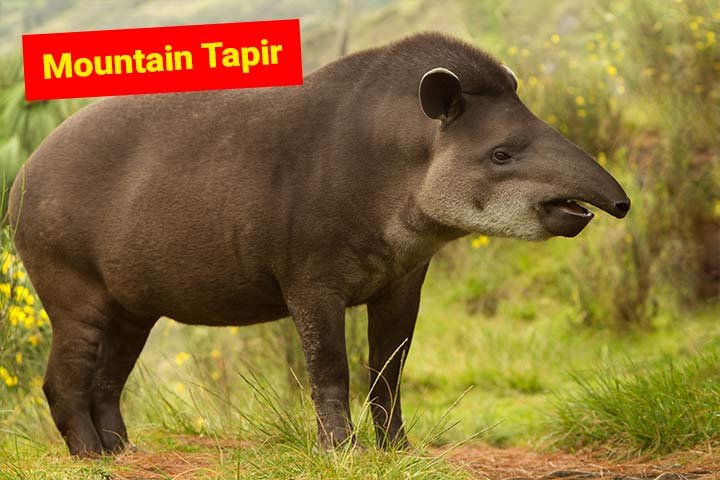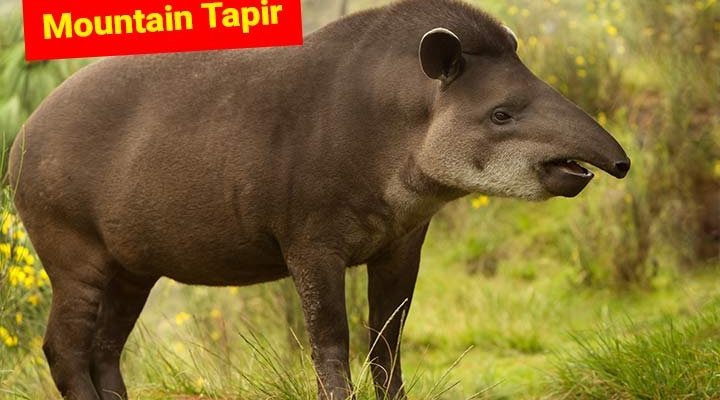
In this article, we’ll dig into the common myths and misconceptions about the mountain tapir. We’ll explore their habitat, diet, behavior, and conservation status. It’s like peeling back the layers of a mystery, revealing the real story behind this remarkable animal. So, grab a cup of coffee, and let’s unravel the truths about the mountain tapir together!
The Mountain Tapir Isn’t Just a Regular Tapir
You might be thinking, “Aren’t all tapirs the same?” Well, here’s the thing: the mountain tapir is its own unique species, separate from the more commonly known lowland tapirs. While they share some similarities, mountain tapirs are particularly adapted to their high-altitude homes in Colombia, Ecuador, and northern Peru.
These creatures are a bit smaller than their lowland cousins, with shorter legs and a more rounded body. Mountain tapirs have thick fur that helps them stay warm in the chilly mountain air. Their color can range from dark brown to gray, allowing them to camouflage seamlessly among rocks and trees. Plus, they have a distinctive snout that’s perfect for foraging for vegetation in their mountainous habitat. If you think of them as mountain climbers—albeit very slow ones—you’ll start to appreciate just how special these tapirs really are.
Mountain Tapir Habitat: High Places, Low Temperatures
So, where do mountain tapirs call home? As the name suggests, these guys prefer the high-altitude regions of the Andes, typically between 2,500 and 4,500 meters above sea level. This isn’t exactly your typical neighborhood!
The environment is characterized by cool temperatures and thick cloud forests, often shrouded in mist. These forests are rich in vegetation, providing the tapirs with plenty of leaves, fruits, and shrubs to munch on. You might wonder how they adapt to such conditions. Well, their thick fur acts like a cozy blanket, keeping them warm. And their strong legs lets them navigate steep hills and rocky terrain with ease—kind of like nature’s own little mountain goats!
Myth: Mountain Tapirs Are Dangerous
You might hear someone claim that mountain tapirs are dangerous creatures, ready to charge if threatened. Honestly, that couldn’t be further from the truth! Mountain tapirs are shy and elusive animals. They prefer to stay hidden rather than confront a potential threat.
If you happen to spot one in the wild, you’ll likely see it move cautiously, often darting away at the first sign of danger. Their main defense mechanism is their ability to blend into their environment, not aggression. In fact, they would rather nibble on foliage than fight back. So, if you ever find yourself near a mountain tapir, consider yourself lucky—but don’t worry about them coming after you!
Behavior and Social Structure
Mountain tapirs are generally solitary creatures but can occasionally be seen in small family groups. They communicate with each other using a variety of sounds, including whistles and grunts. Imagine them having their own little conversations in the forest, warning each other of potential dangers or letting each other know where the tastiest snacks are hiding.
Unlike some animals that gather in large herds, mountain tapirs prefer their own company, often roaming alone to forage for food. This behavior helps them conserve energy in the high-altitude environment, where food can sometimes be sparse. So, while they might not be the social butterflies of the animal kingdom, they’ve got their own way of living life to the fullest in the mountains!
Myth: Mountain Tapirs Are Endangered Because They’re Not Important
One of the biggest myths is that mountain tapirs don’t contribute much to their ecosystem, and this misconception can be harmful. The truth is, these animals play a crucial role in maintaining their habitats. By feeding on various plants, they help shape the vegetation of their environment.
When mountain tapirs munch on leaves, they promote new growth and ensure diverse plant life. This, in turn, supports other wildlife in the area. So, the next time you hear someone say they’re not important, just remember: every species has its place in the circle of life, and mountain tapirs are no exception.
Conservation Status: What’s Happening to Mountain Tapirs?
Unfortunately, mountain tapirs are considered endangered due to habitat loss, hunting, and climate change. Logging and farming in the Andes have reduced their natural habitat, making it challenging for them to survive. This is where conservation efforts come into play.
Organizations are working hard to protect these animals and their homes. Many are pushing for stronger regulations against hunting and promoting awareness about the importance of mountain tapirs in their ecosystems. You might feel a bit helpless, but supporting these initiatives can be a way for all of us to contribute to their future.
Myth: Mountain Tapirs Don’t Need Our Help
If you think mountain tapirs can survive without human intervention, think again! As we discussed earlier, habitat destruction and climate change are real threats to their existence. They need our help more than ever.
Conservation programs are key to ensuring the survival of mountain tapirs. By donating to wildlife organizations and spreading the word about their plight, you can help raise awareness. Just a little bit of support can make a difference. Remember, when we protect mountain tapirs, we’re also preserving the rich biodiversity of the Andes.
Getting Involved with Conservation
Want to make a difference? There are plenty of ways to get involved! Here are a few ideas to get you started:
- Support wildlife conservation organizations that focus on mountain tapirs.
- Educate your friends and family about the importance of these unique creatures.
- Participate in local conservation efforts or initiatives aimed at protecting wildlife.
Every small effort counts, and together we can help save our furry friends in the mountains!
When it comes to the mountain tapir, separating fact from fiction is essential. These incredible animals are not just regular tapirs—they’re unique beings with roles to play in their ecosystems. From their adaptations to high-altitude living to their shy nature, there’s so much more to them than meets the eye.
As we learn about the myths surrounding the mountain tapir, let’s remember that these creatures deserve our attention and protection. Their survival depends on our awareness and action. So, the next time you hear a myth about the mountain tapir, you’ll be ready to set the record straight! Together, let’s nurture a future where mountain tapirs continue to roam the Andes, a treasured part of our planet’s diverse wildlife.

